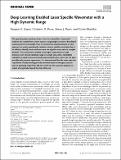Files in this item
Deep learning enabled laser speckle wavemeter with a high dynamic range
Item metadata
| dc.contributor.author | Gupta, Roopam K. | |
| dc.contributor.author | Bruce, Graham D. | |
| dc.contributor.author | Powis, Simon J. | |
| dc.contributor.author | Dholakia, Kishan | |
| dc.date.accessioned | 2020-08-03T10:30:02Z | |
| dc.date.available | 2020-08-03T10:30:02Z | |
| dc.date.issued | 2020-09 | |
| dc.identifier | 262382944 | |
| dc.identifier | eec784e1-3bbc-4645-9a25-0bd713463b27 | |
| dc.identifier | 000554481800001 | |
| dc.identifier | 85088858681 | |
| dc.identifier.citation | Gupta , R K , Bruce , G D , Powis , S J & Dholakia , K 2020 , ' Deep learning enabled laser speckle wavemeter with a high dynamic range ' , Laser & Photonics Reviews , vol. 14 , no. 9 , 2000120 . https://doi.org/10.1002/lpor.202000120 | en |
| dc.identifier.issn | 1863-8899 | |
| dc.identifier.other | ArXiv: http://arxiv.org/abs/1910.10702v1 | |
| dc.identifier.other | ORCID: /0000-0003-4218-2984/work/78527531 | |
| dc.identifier.other | ORCID: /0000-0003-3403-0614/work/78528004 | |
| dc.identifier.other | ORCID: /0000-0002-3267-9009/work/78528384 | |
| dc.identifier.uri | https://hdl.handle.net/10023/20392 | |
| dc.description | Funding: This work was supported by a Medical Research Scotland PhD studentship PhD 873-2015 awarded to R.K.G, and grant funding from Leverhulme Trust (RPG-2017-197) and UK Engineering and Physical Sciences Research Council (grant EP/P030017/1). | en |
| dc.description.abstract | The speckle pattern produced when a laser is scattered by a disordered medium has recently been shown to give a surprisingly accurate or broadband measurement of wavelength. Here it is shown that deep learning is an ideal approach to analyse wavelength variations using a speckle wavemeter due to its ability to identify trends and overcome low signal to noise ratio in complex datasets. This combination enables wavelength measurement at high precision over a broad operating range in a single step, with a remarkable capability to reject instrumental and environmental noise, which has not been possible with previous approaches. It is demonstrated that the noise rejection capabilities of deep learning provide attometre-scale wavelength precision over an operating range from 488 nm to 976 nm. This dynamic range is six orders of magnitude beyond the state of the art. | |
| dc.format.extent | 8 | |
| dc.format.extent | 1899624 | |
| dc.language.iso | eng | |
| dc.relation.ispartof | Laser & Photonics Reviews | en |
| dc.subject | Automated noise rejection | en |
| dc.subject | Deep learning | en |
| dc.subject | Speckle metrology | en |
| dc.subject | Wavelength measurement | en |
| dc.subject | QC Physics | en |
| dc.subject | R Medicine | en |
| dc.subject | T Technology | en |
| dc.subject | DAS | en |
| dc.subject.lcc | QC | en |
| dc.subject.lcc | R | en |
| dc.subject.lcc | T | en |
| dc.title | Deep learning enabled laser speckle wavemeter with a high dynamic range | en |
| dc.type | Journal article | en |
| dc.contributor.sponsor | EPSRC | en |
| dc.contributor.sponsor | The Leverhulme Trust | en |
| dc.contributor.institution | University of St Andrews. School of Medicine | en |
| dc.contributor.institution | University of St Andrews. School of Physics and Astronomy | en |
| dc.contributor.institution | University of St Andrews. Centre for Biophotonics | en |
| dc.contributor.institution | University of St Andrews. Biomedical Sciences Research Complex | en |
| dc.contributor.institution | University of St Andrews. Cellular Medicine Division | en |
| dc.contributor.institution | University of St Andrews. Sir James Mackenzie Institute for Early Diagnosis | en |
| dc.identifier.doi | 10.1002/lpor.202000120 | |
| dc.description.status | Peer reviewed | en |
| dc.identifier.grantnumber | EP/P030017/1 | en |
| dc.identifier.grantnumber | RPG-2017-197 | en |
This item appears in the following Collection(s)
Items in the St Andrews Research Repository are protected by copyright, with all rights reserved, unless otherwise indicated.

